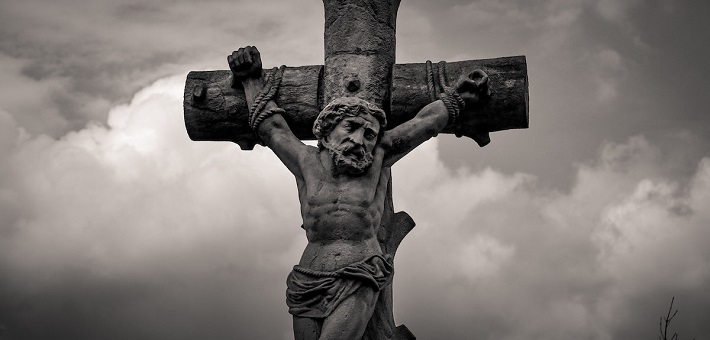Commentary on Matthew 27:27-61
Since Matthew 16:21, Jesus has predicted a final confrontation with Roman power in Jerusalem that will result in his death. In Matthew 19-20 he travels from Galilee to Jerusalem. Conflicts with the Rome-sanctioned Judean leaders secure his death (Matthew 21-25). The process to crucifixion involves Jesus’ betrayal, arrest, interrogation, and condemnation by the Roman governor (26:1-27:26).
Matthew 27:27-61 secures the path to Jesus’ death by crucifixion, the ultimate expression of societal exclusion. Verses 27-44 narrate a ritual of elite-supervised, pre-death, mocking, humiliation and torture. Verses 45-56 narrate Jesus’ death. Verses 57-61 narrate his burial.
The first act of humiliation occurs in the governor’s headquarters or praetorium (27:27-31).
- The location represents the empire’s power that is being asserted over the low status, provincial, kingly wannabe Jesus. Rome has not sanctioned his power.
- The agents of the humiliation are the governor’s hostile soldiers. These societally-sanctioned agents enact the state-sponsored violence and humiliation that is embedded in the Roman judicial system.
- They mock Jesus by presenting him with royal insignia: a scarlet robe, a crown of thorns, a scepter (27:28-30).
- Four actions mock him: fake submission expressed in kneeling; verbal mocking (“king of the Jews”); spitting; and the torture of striking him.
The Gospel, however, has located him in the royal line of David (Matthew 1:1) and constructed him as the eschatological king (25:34).
They lead the socially-deviant Jesus to crucifixion. Crucifixion is the ultimate statement of the elite’s rejection of Jesus as an unsanctioned king. They consider him a terroristic threat to their self-benefitting societal order. Parading Jesus to the public location of his crucifixion intimidates the population and exercises societal control. So too does forcing the north African Simon from Cyrene, a city in present-day Libya, capital of the province of Cyrenaica, to carry Jesus’ cross.
The coercion of Simon’s labor is an example of the imperial practice of angareia. Roman imperial officials requisitioned labor, transport (animals, ships, carts), and lodging from subject people. Jesus employs this practice in procuring the donkeys in 21:1-7 (see also 5:40-41).
The narrative hurries over the humiliating act of crucifixion (Matthew 27:33-37). Crucifixion was a form of capital punishment reserved for political rebels, low-status provincials, and slaves. The narrative notes the place, the offering of wine, the seizing of Jesus’ clothes, and the criminal identification of Jesus as an unsanctioned, treasonous, political rebel, “king of the Jews.”
The narrative continues to highlight Jesus’ humiliation. He is crucified in the shameful company of two terrorists or insurrectionists (Matthew 27:38). Passers-by in this public place deride this kingly wannabe with head-shaking and verbal abuse. Their verbal mocking reprises the false charge from 26:61 that he would destroy the temple. Ironically, in the Gospel’s perspective, their rejection of Jesus leads to the temple’s destruction in 70 CE (22:7). They taunt Jesus, as did the devil in the temptations of 4:1-11, to show his power as God’s agent or son and free himself from the cross (27:39-41).
The second group of mockers comprise the Rome-allied Judean leaders (27:41-43). They speak about, but not to, Jesus. They mock his failure to save himself. They accurately identify him as king and God’s son. It is not, though, a confession of his identity as God’s agent.
The bandits or terrorists form a third group of mockers but their mockery is not articulated (27:44).
Verses 45-50 narrate Jesus’ death, highlighting three moments.
Darkness covers the land from noon to 3pm. Previously, the Gospel referred to the Roman occupation of Galilee as darkness (Matthew 4:15-16). Jesus’ crucifixion displays that darkness. Darkness also anticipates Rome’s downfall. Jesus’ victorious return extinguishes the heavenly powers and lights that sanction Roman rule (24:29).
Second, Jesus’ loud cry from the cross cites Psalm 22:1 (27:46). The citation constructs Jesus as a sufferer faithful to the divine purposes who is opposed by God’s enemies yet anticipates God’s deliverance. This spirituality provides an interpretive paradigm that pervades the passion narrative.
Third, bystanders think Jesus calls on Elijah to rescue him. They offer him ameliorative wine. Jesus dies with a loud cry (Matthew 27:47-49).
The narrative now makes an audacious move. It interprets the significance of Jesus’ crucifixion by associating it with three signs of judgment. The one whom Roman imperial power discarded as a low-status, kingly wannabe and threat to its structures is constructed as the key participant in the yet-future establishment of God’s empire.
The first phenomenon involves the Jerusalem temple curtain which is torn from top to bottom (Matthew 27:51). This act has nothing to do with horrible Christian supercessionist claims that access to God is now available. Rather, this act interprets Rome’s destruction of the temple in 70 CE. In the Gospel’s perspective, the temple’s destruction signifies judgment on the Rome-sanctioned elite for crucifying Jesus.
The second phenomenon is an earthquake. Frequently earthquakes signal the new age of divine rule (Matthew 24:7). The earthquake anticipates God’s final victory over the nations in Zechariah 14:4-5 where an earthquake splits the Mount of Olives.
The third phenomenon is the strange vision of open tombs and bodies resurrected from the dead who roam the city of Jerusalem (Matthew 27:52-53). Jesus’ death means life for others.
The section ends with responses to Jesus’ death from three parties.
- The first response comprises the declaration of the centurion (and others guarding Jesus) that Jesus is God’s son (Matthew 27:54). Is the statement a confession or mocking and derisive?
- The second group comprises many women followers of Jesus who watch “from a distance” (27:55-56). These women followers have not been identified previously but are presented as disciples who accompanied and served Jesus in Galilee. Two of them position themselves “opposite the tomb” as witnesses (27:61) and anticipate Jesus’ resurrection (28:1).
- The third party, the wealthy Joseph of Arimathea, is also a disciple though not listed in 10:2-4. He honors Jesus with burial (27:57-60). Rolling the stone across the tomb suggests that this disciple does not expect Jesus’ resurrection.
It looks like Roman power has won. Appearances, though, can be deceptive.
PRAYER OF THE DAY
Grieved God, your only son Jesus fell to the earthly desires of humanity. Forgive us for our sin and restore us to your grace. We pray these things in the name of Jesus Christ, our Savior and Lord. Amen.
HYMNS
Ah, holy Jesus ELW 349, H82 158, UMH 289, NCH 218
They crucified my Lord ELW 350/trad.
CHORAL
The Crucifixion, John Stainer


April 7, 2023